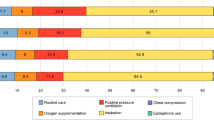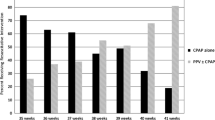Abstract
Objective
To describe trends in the incidence and severity of meconium aspiration syndrome (MAS) around the release of revised Neonatal Resuscitation Program (NRP) guidelines in 2016.
Study design
The California Perinatal Quality Care Collaborative database was queried for years 2013–2017 to describe the incidence and outcomes of infants with MAS. Results were analyzed based on both individual years and pre- vs. post-guideline epochs (2013–15 vs. 2017).
Result
Incidence of MAS decreased significantly from 2013–15 to 2017 (1.02 to 0.78/1000 births, p < 0.001). Among infants with MAS, delivery room intubations decreased from 2013–15 to 2017 (44.3 vs. 35.1%; p = 0.005), but similar proportion of infants required invasive respiratory support (80.1 vs. 80.8%), inhaled nitric oxide (28.8 vs. 28.4%) or extracorporeal membrane oxygenation (0.81 vs. 0.35%).
Conclusion
While the study design precludes confirmation of implementation of the recent NRP recommendation, there was no increase in the incidence or severity of MAS following its release.
This is a preview of subscription content, access via your institution
Access options
Subscribe to this journal
Receive 12 print issues and online access
$259.00 per year
only $21.58 per issue
Buy this article
- Purchase on Springer Link
- Instant access to full article PDF
Prices may be subject to local taxes which are calculated during checkout

Similar content being viewed by others
References
Weiner GM, Zaichkin J. Textbook of neonatal resuscitation. Elk Grove: American Academy of Pediatrics and American Heart Association; 2016.
Wyckoff MH, Aziz K, Escobedo MB, Kapadia VS, Kattwinkel J, Perlman JM, et al. Part 13: Neonatal Resuscitation: 2015 American Heart Association Guidelines Update for Cardiopulmonary Resuscitation and Emergency Cardiovascular Care. Circulation 2015;132(18Suppl 2):S543–60.
Perlman JM, Wyllie J, Kattwinkel J, Wyckoff MH, Aziz K, Guinsburg R, et al. Part 7: Neonatal Resuscitation: 2015 International Consensus on Cardiopulmonary Resuscitation and Emergency Cardiovascular Care Science With Treatment Recommendations. Circulation 2015;132(16Suppl 1):S204–41.
Wiswell TE, Gannon CM, Jacob J, Goldsmith L, Szyld E, Weiss K, et al. Delivery room management of the apparently vigorous meconium-stained neonate: results of the multicenter, international collaborative trial. Pediatrics. 2000;105(1 Pt 1):1–7.
Fraser WD, Hofmeyr J, Lede R, Faron G, Alexander S, Goffinet F, et al. Amnioinfusion for the prevention of the meconium aspiration syndrome. N Engl J Med. 2005;353:909–17.
Vain NE, Szyld EG, Prudent LM, Wiswell TE, Aguilar AM, Vivas NI. Oropharyngeal and nasopharyngeal suctioning of meconium-stained neonates before delivery of their shoulders: multicentre, randomised controlled trial. Lancet. 2004;364:597–602.
Chettri S, Adhisivam B, Bhat BV. Endotracheal suction for nonvigorous neonates born through meconium stained amniotic fluid: a randomized controlled trial. J Pediatr. 2015;166:1208–13.e1.
Nangia S, Sunder S, Biswas R, Saili A. Endotracheal suction in term non vigorous meconium stained neonates-A pilot study. Resuscitation. 2016;105:79–84.
Singh SN, Saxena S, Bhriguvanshi A, Kumar M, Chandrakanta, Sujata. Effect of endotracheal suctioning just after birth in non-vigorous infants born through meconium stained amniotic fluid: A randomized controlled trial. Clin Epidemiol Glob Health. 2019;7:165–70.
Chiruvolu A, Miklis KK, Chen E, Petrey B, Desai S. Delivery room management of meconium-stained newborns and respiratory support. Pediatrics. 2018;142:e20181485.
Wiswell TE. Appropriate management of the nonvigorous meconium-stained neonate: an unanswered question. Pediatrics. 2018;142:e20183052.
Edwards EM, Lakshminrusimha S, Ehret DEY, Horbar JD. NICU admissions for meconium aspiration syndrome before and after a national resuscitation program suctioning guideline change. Children. 2019;6:68.
Vain NE, Batton DG. Meconium “aspiration” (or respiratory distress associated with meconium-stained amniotic fluid?). Semin Fetal Neonatal Med. 2017;22:214–9.
Martin JA, Hamilton BE, Osterman MJK, Driscoll AK, Drake P. Births: final data for 2017. Natl Vital Stat Rep. 2018;67:1–50.
Fischer C, Rybakowski C, Ferdynus C, Sagot P, Gouyon JB. A population-based study of meconium aspiration syndrome in neonates born between 37 and 43 weeks of gestation. Int J Pediatr. 2012;2012:321545.
Cheng YW, Nicholson JM, Nakagawa S, Bruckner TA, Washington AE, Caughey AB. Perinatal outcomes in low-risk term pregnancies: do they differ by week of gestation? Am J Obstet Gynecol. 2008;199:370 e1–7.
Lee J, Romero R, Lee KA, Kim EN, Korzeniewski SJ, Chaemsaithong P, et al. Meconium aspiration syndrome: a role for fetal systemic inflammation. Am J Obstet Gynecol. 2016;214:366.e1–9.
Pandita A, Murki S, Oleti TP, Tandur B, Kiran S, Narkhede S, et al. Effect of nasal continuous positive airway pressure on infants with meconium aspiration syndrome: a randomized clinical trial. JAMA Pediatr. 2018;172:161–5.
Murphy JD, Vawter GF, Reid LM. Pulmonary vascular disease in fatal meconium aspiration. J Pediatr. 1984;104:758–62.
Lakshminrusimha S, Mathew B, Nair J, Gugino SF, Koenigsknecht C, Rawat M, et al. Tracheal suctioning improves gas exchange but not hemodynamics in asphyxiated lambs with meconium aspiration. Pediatr Res. 2015;77:347–55.
Kinsella JP. Inhaled nitric oxide in the term newborn. Early Hum Dev. 2008;84:709–16.
Konduri GG, Kim UO. Advances in the diagnosis and management of persistent pulmonary hypertension of the newborn. Pediatr Clin North Am. 2009;56:579–600.
Lakshminrusimha S, Konduri GG, Steinhorn RH. Considerations in the management of hypoxemic respiratory failure and persistent pulmonary hypertension in term and late preterm neonates. J Perinatol. 2016;36(Suppl 2):S12–9.
Mahmood B, Newton D, Pallotto EK. Current trends in neonatal ECMO. Semin Perinatol. 2018;42:80–8.
Viraraghavan VR, Nangia S, Prathik BH, Madarkar BS, Rani D, Saili A. Yield of meconium in non-vigorous neonates undergoing endotracheal suctioning and profile of all neonates born through meconium-stained amniotic fluid: a prospective observational study. Paediatr Int Child Health. 2018;38:266–70.
Acknowledgements
We gratefully acknowledge all site data abstractors of the California Perinatal Quality Care Collaborative (CPQCC). The project described was supported by NIH Grant (HD 072929) and Faculty development fund at UC Davis School of Medicine.
Author information
Authors and Affiliations
Contributions
VKK and SL conceptualized and designed the study, submitted IRB application, drafted and analyzed tables, drafted initial paper, and reviewed and revised the subsequent paper. HCL contributed to study design, critically reviewed and revised the paper for important intellectual content. LS contributed to study design, conducted statistical analysis, and critically reviewed and revised the paper for important intellectual content. AWR critically reviewed the paper and performed statistical analysis. MU critically reviewed and revised the paper for intellectual content. All authors approve the final paper as submitted and agree to be accountable for all aspects of the work.
Corresponding author
Ethics declarations
Conflict of interest
The authors declare that they have no conflict of interest.
Additional information
Publisher’s note Springer Nature remains neutral with regard to jurisdictional claims in published maps and institutional affiliations.
Rights and permissions
About this article
Cite this article
Kalra, V.K., Lee, H.C., Sie, L. et al. Change in neonatal resuscitation guidelines and trends in incidence of meconium aspiration syndrome in California. J Perinatol 40, 46–55 (2020). https://doi.org/10.1038/s41372-019-0529-0
Received:
Revised:
Accepted:
Published:
Issue Date:
DOI: https://doi.org/10.1038/s41372-019-0529-0
This article is cited by
-
Kindliche Notfälle im Kreißsaal – Teil 1
Die Gynäkologie (2023)
-
Neonatal outcomes of non-vigorous neonates with meconium-stained amniotic fluid before and after change in tracheal suctioning recommendation
Journal of Perinatology (2022)
-
Versorgung und Reanimation des Neugeborenen nach der Geburt
Notfall + Rettungsmedizin (2021)
-
Current Practices and Updates in Neonatal Resuscitation
Current Pediatrics Reports (2020)



